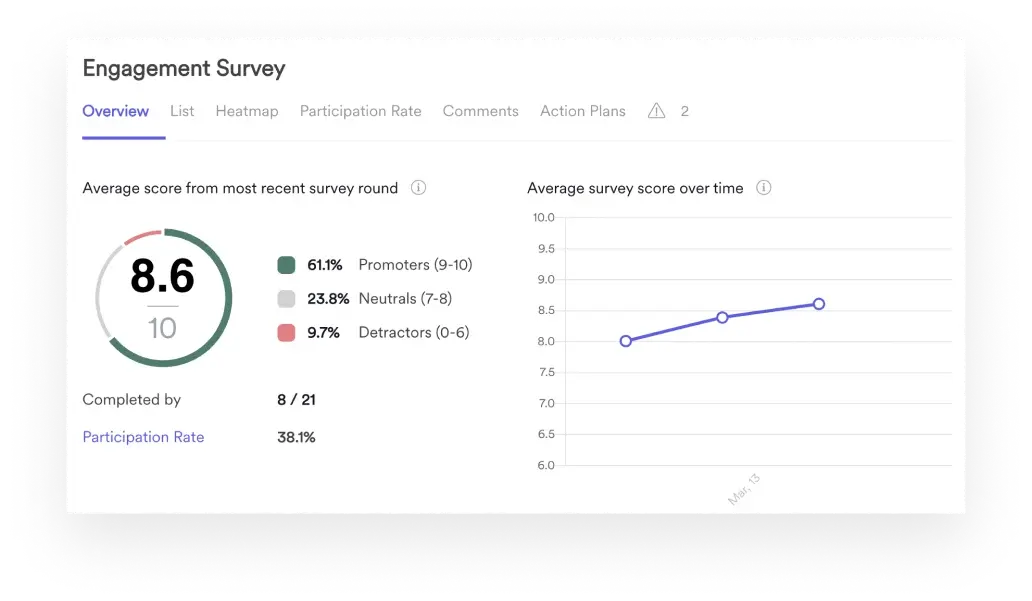7 tools for creating a winning company culture in 2026

As companies face the unprecedented challenges that remote and hybrid work environments and dispersed teams present, leaders are placing a greater emphasis on culture to create more consistency in staying aligned, innovating, collaborating, and solving problems. Doing so also yields positive business outcomes: Research has found that 73% of employees said culture “impacts their ability to do their best work,” and 72% said culture “drives productivity and efficiency.” (1)
At the same time, organizations are leveraging culture to drive employee engagement and make work more meaningful. In our 2023 State of People Enablement Report, we found that the top engagement enablers were “transparent performance review processes,” “opportunities to take ownership and develop skills,” and “regular learning and development opportunities.” (2)
Culture software allows today’s companies to streamline their workflows for communication and collaboration and assist team members in growing within their organization by simplifying their performance and development processes. As a result, company culture software can help you make work more impactful for employees and drive stronger business outcomes. Our list of seven effective culture platforms explores what makes each solution unique and why it might deserve a place in your tech stack.*
- St. Paul/Minneapolis Business Journal, 2023
- Leapsome, 2023
*The information below is based on our research in 2023. All user feedback referenced in the text has been sourced from independent software review platforms such as G2 and Capterra in August-September 2023.

How software can help you build a resilient & positive company culture
Organizations that are looking to establish a strong internal company culture in their day-to-day work and leverage data to make improvements will find that the right platform — or combination of platforms — can help by eliminating ambiguity, improving communication and alignment, and streamlining processes. Specific benefits of a powerful culture software solution include:
Higher engagement levels
Company culture tools like surveys allow employees to make their voices heard and participate in shaping their work environment, ensuring they’re in line with your mission and values as the company grows and evolves.
Increased productivity
Develop a more results-oriented workplace by using culture platforms to set company goals and create more alignment with department and team objectives.
Increased transparency
Many company culture software solutions come with built-in performance management features to make employee evaluations standardized and data-driven, giving team members full visibility over the factors that affect their assessments and the skills needed to progress in their careers.
Clear development paths
Features like competency frameworks and integrated learning paths help team members understand and dive into the skills they need to advance within the company and as professionals.
Unbiased decision-making
Compensation management tools mean more consistent, analytics-based pay and promotion processes, which facilitate a culture of fairness and equity.
Detailed analytics
In-depth reporting and analytics help you easily navigate employee responses and make more unbiased, data-driven decisions.
1. Leapsome

There are so many factors that can influence your culture. That’s why Leapsome includes engagement, performance management, goal setting, and compensation modules among its comprehensive set of products, allowing you to effectively integrate and manage your culture initiatives from every angle.
Our interconnected products empower people-centered organizations to:
- Conduct collaborative, development-focused performance reviews
- Set cascading goals and OKRs
- Help employees build crucial skills and grow as professionals
- Promote more people internally with clear processes and competency frameworks
- Create dynamic, customized learning content
- Conduct surveys by using custom questions or templates from our library
- Exchange feedback and encourage colleagues to share recognition and praise
- Use people analytics to make sure all goals, initiatives, and processes are on the right track
Leapsome is ideal for companies that are looking to build, revamp, or maintain their culture with the right scalable processes. Consider Eurowings Digital, for instance. With the help of Leapsome’s surveys, they were able to identify initiatives that specifically target challenges within the organization, which enabled them to reduce its employee turnover rate from 18% to 5.8% and increase its average Employee Net Promoter Score (eNPS) from 7.9 to 8.5.
Key features
- Performance and 360-degree reviews
- Anonymous engagement and pulse surveys and templates with automatic action plan recommendations and sentiment analysis for open-ended questions
- Automated onboarding and exit surveys
- Competency frameworks
- Instant feedback feature that allows for public praise and private feedback
- Anonymous Q&A board that lets employees ask high-level questions and get answers from leadership
- In-depth analytics for tracking engagement and activity across all modules
- 1:1 and team meeting templates
- Compensation and promotion tools
- Built-in learning platform
- Holistic people enablement tool
- Intuitive user interface (UI)
- Supports 38 languages
- Highly scalable
- Customizable goal-setting and surveys features
- Attentive customer service team
- Continuous iteration can lead to occasional bugs
- Mobile app not yet available
What success looks like with Leapsome
Build an employee-centric culture you’re proud of
Leapsome helps you pinpoint what’s amiss with your culture and take meaningful action with intuitive processes and targeted initiatives.
Book your demo
2. Engagedly

If you work with employees in more technical roles or simply have a large company with diverse teams and job titles, Engagedly might be an option for you. The platform allows users to create unique performance review templates for different departments, levels, and positions. It can also automatically retrieve data from its goals feature so managers can make review discussions more focused and outcome-oriented.
Another noteworthy feature is Engagedly’s gamification function. You can use badges, points, and tangible rewards as motivating incentives, encouraging employees to participate in programs, complete particular tasks, or meet specific targets.
Key features
- Performance management features
- Customizable performance review templates for different roles
- Engagement surveys
- Gamification function for rewards and recognition
- Built-in learning platform
- Employee development planning features
Simple platform design
- list item
- UI can feel outdated and buggy
- High starting annual agreement cost
- list item
3. Humu

Humu is a people analytics platform that offers a large library of behavioral “nudges,” or short action recommendations for leaders and managers designed to motivate positive behavior that impacts an organization.
Recently acquired by Perceptyx, an employee listening and manager effectiveness platform, Humu will now be integrated into Perceptyx’s People Insights Platform so that it can deliver nudges to both leaders and employees.
Key features
- Behavioral science framework for mapping where your company needs to improve
- “Nudges,” or short action recommendations to encourage specific behaviors
- Engagement survey tools and templates
- Analytics that integrate with human resources information systems (HRIS) and employee data
Not many user reviews available
- list item
Not many user reviews available
- list item
4. Mo

Mo is a practical platform for any business that aims to create a more powerful culture of recognition, praise, and appreciation and integrate it smoothly into their day-to-day workflows. For instance, the Boost feature sends leaders automated prompts that encourage them to celebrate wins, post a humble brag or lesson learned, or simply share a moment that made them laugh.
Mo is also perfect for any organization that’s building its recognition and rewards program from the ground up with a public dashboard for celebrating team member wins. Users can even link those wins with tangible prizes like gift cards or reward credits.
Key features
- Public feed for celebrating team member wins
- Customizable team profiles
- Option to integrate tangible rewards
- Integrates with Slack and Microsoft Teams
- Incentivizes employee recognition
- user-friendly
- list item
- Some issues when claiming reward codes
- UI could be improved
- list item
5. Motivosity

Motivosity focuses on improving internal culture through peer-to-peer recognition in a social-media-like platform. Employees can create their own social profiles and share wins and praise on appreciation dashboards. Team leads can learn more about their reports’ strengths and weaknesses and cater their managerial style to meet team members’ needs.
On top of that, Motivosity offers one-on-one meeting agenda templates and manager development frameworks so team leads have the tools they need in their leadership roles.
Key features
- Employee personality and social profiles
- Appreciation feed
- Rewards and recognition workflows and incentives
- Engagement surveys, pulse surveys, and eNPS scoring
- Manager development and one-on-one meeting tools
modular pricing
- list item
- Reportedly steep learning curve
- Users report glitches especially when logging in
- list item
6. Officevibe

Officevibe is an employee experience platform for businesses looking to create cultures centered around positivity and transparency. You can use Offievibe to run customizable surveys and automate regular pulse surveys with built-in questions to capture your eNPS. Its Good Vibes peer recognition dashboard encourages team members to uplift each other with specific positive feedback based on your company values.
A new feature worth noting is the continuous performance tool, which enables managers to offer more frequent feedback and coaching. With this feature, you can incorporate more frequent check-ins and conversations into your evaluation cycle, making your annual or semi-annual reviews more productive and less intimidating.
Key features
- Pulse surveys and eNPS scoring tools
- Continuous performance review cycle builder
- Goal-setting and OKR tools
- Employee and peer-to-peer recognition dashboard
- Anonymous feedback and messaging feature
- One-on-one and weekly check-in tools
forever free plan for small teams (up to 10) with limited functionality
- list item
- lacks customization options
- Reportedly buggy and difficult to use
- If using their survey tool you can only choose from their question catalogue
- list item
7. Worktango

Previously branded as Kazoo, WorkTango offers an employee experience platform integrating surveys, employee feedback, goals and OKR tracking, along with incentives, aiming to boost employee engagement and company culture within organizations.
Key features
- Feedback and praise among peers
- Gamification of employee achievements
- A standout trait of WorkTango is its function that promotes employee motivation and enhances involvement by rewarding actions such as accomplishing fitness routines, participating in volunteer work, organizing cultural gatherings, or assisting in new employee onboarding.
- Enhances morale through its gamified elements
- Fosters an environment of appreciation and acknowledgment
- list item
- User experience reportedly needs significant enhancements
- Users have encountered glitches, extended loading periods, and problems with the points system.
- list item
Frequently Asked Questions
Provides clarity on work expectations by providing a centralized location for answers;Gives employees a place to provide open and constructive feedback on the workplace;Cuts down on the amount of physical paperwork employees need to sign and keep track of.
Provides clarity on work expectations by providing a centralized location for answers;Gives employees a place to provide open and constructive feedback on the workplace;Cuts down on the amount of physical paperwork employees need to sign and keep track of.
Provides clarity on work expectations by providing a centralized location for answers;Gives employees a place to provide open and constructive feedback on the workplace;Cuts down on the amount of physical paperwork employees need to sign and keep track of.
Provides clarity on work expectations by providing a centralized location for answers;Gives employees a place to provide open and constructive feedback on the workplace;Cuts down on the amount of physical paperwork employees need to sign and keep track of.
Common Pricing questions
Our Customer Success team will help you get up and running and guide you to customize Leapsome to your organization’s needs. To learn more about the services we offer, head to our customer experience page.
Please note: Our customer success team’s services are only available to customers who implement Leapsome with an annual contract of €6,000 (or US$6,000) or more. However, ongoing email support and our Success Center of articles, videos, and best-practice resources are always available for all customers.
Yes, absolutely! You can test out Leapsome free of charge for a full 14 days — no credit card required.
Pricing depends on the number of employees, modules used, and contract length. You can use the calculator above to see an estimate of the price per employee per month by selecting the modules that you are interested in but please reach out to get a quote.
Continuous feedback is essential for employee development. To facilitate this, the Competency Framework, Instant Feedback, and Meetings modules are included in all plans, for all customers, at no extra cost.
These features are tightly integrated with the other parts of the platform. You can think of these as the glue that binds your processes together, giving your employees the tools to establish a culture of regular feedback and recognition.
Thanks to our best practice frameworks, Leapsome is ready to use from day 1. The setup is made easy with integrations with major HRIS platforms. Full implementation is usually done in 1–4 weeks.
There’s no setup fee and no additional or hidden costs!
The Leapsome platform — including all email notifications — is available in 13 languages: Chinese, Dutch, English, French, German, Italian, Japanese, Korean, Polish, Portuguese, Russian, Spanish, and Swedish. Our sales team, customer support team, and our Success Center are available in English and German.
Our Customer Success team will help you get up and running and guide you to customize Leapsome to your organization’s needs. To learn more about the services we offer, head to our customer experience page.
Please note: Our customer success team’s services are only available to customers who implement Leapsome with an annual contract of €6,000 (or US$6,000) or more. However, ongoing email support and our Success Center of articles, videos, and best-practice resources are always available for all customers.
Yes, absolutely! You can test out Leapsome free of charge for a full 14 days — no credit card required.
Pricing depends on the number of employees, modules used, and contract length. You can use the calculator above to see an estimate of the price per employee per month by selecting the modules that you are interested in but please reach out to get a quote.
Continuous feedback is essential for employee development. To facilitate this, the Competency Framework, Instant Feedback, and Meetings modules are included in all plans, for all customers, at no extra cost.
These features are tightly integrated with the other parts of the platform. You can think of these as the glue that binds your processes together, giving your employees the tools to establish a culture of regular feedback and recognition.
Thanks to our best practice frameworks, Leapsome is ready to use from day 1. The setup is made easy with integrations with major HRIS platforms. Full implementation is usually done in 1–4 weeks.
There’s no setup fee and no additional or hidden costs!
The Leapsome platform — including all email notifications — is available in 13 languages: Chinese, Dutch, English, French, German, Italian, Japanese, Korean, Polish, Portuguese, Russian, Spanish, and Swedish. Our sales team, customer support team, and our Success Center are available in English and German.
Company culture is important because it plays a significant role in shaping the identity, values, and behaviors of an organization. It can influence business success in several ways:
- Employee engagement and productivity — When employees feel valued, motivated, and connected with their culture, they’re more likely to feel engaged with their work, leading to increased productivity and better job performance.
- Talent attraction and retention — When a company is known for its positive culture, it’s more likely to become an employer of choice. High-performing individuals are also more likely to stay with an organization where they feel supported and aligned with the values.
- Adaptability and resilience — A strong company culture can help an organization adapt to new challenges and bounce back from setbacks in the rapidly changing world of work.
- Innovation and creativity — Employees are more likely to come up with original solutions and ideas when they feel comfortable sharing their thoughts without fear of awkwardness, criticism, or retribution.
There are several possible indicators of a healthy company culture. You can tell if yours is in a good place by assessing whether:
- Team members report feeling engaged via surveys and anonymous feedback.
- Employees understand, feel aligned with, and embody your values and mission.
- Leadership provides regular updates, creates opportunities for feedback, and facilitates a culture of listening to employee concerns.
- Your diversity and equal opportunity practices are driving change and increasing the representation of underrepresented groups.
- Employees make use of resources that support a healthy work-life balance, including flexible work arrangements, time off policies, and wellness programs.
- Team members are taking advantage of your opportunities for learning and development.
Some common tools and approaches that organizations typically use to enhance and cultivate a positive company culture include:
- Employee engagement and pulse surveys to gather candid insights into employee sentiment.
- Continuous feedback and recognition platforms to facilitate transparency, radical candor, and encouragement.
- Performance management software that allows managers to collaborate with employees on aligning personal development goals and projects with the company’s overall strategy.
- Learning and development tools to train and nurture team members and create more opportunities for them to be promoted from within.
- Collaboration and communication tools to enable people to work together better and share company news and updates.
- Compensation management platforms that allow leaders to make fair, transparent promotion and pay decisions.
Measuring the effectiveness of tools and initiatives aimed at improving company culture is crucial to assess their impact and make informed adjustments. You can do so by:
- Defining clear objectives — Start by establishing the specific goals and outcomes you hope to achieve with the culture improvement tools and initiatives. For example, do you want to increase employee engagement, reduce turnover, enhance diversity and inclusion, or improve communication?
- Establishing a cultural baseline — Conduct an initial assessment or survey of your organization's culture before implementing the tools. This provides a baseline against which you can measure changes over time.
- Setting key performance indicators (KPIs) — Identify KPIs that are directly related to your culture improvement goals and tied to specific outcomes. Examples include employee satisfaction scores, turnover rates, and productivity metrics.
- Continuously gathering employee feedback — Use surveys and feedback platforms to track changes in employee sentiment and engagement over time. Compare survey results over different time periods to assess trends and progress.
- Analyzing data — Use data analytics and visualization tools to analyze the data you collect. Look for patterns, correlations, and trends that may indicate improvements or areas that require attention.
- Creating a feedback loop — Share survey results and findings with employees and leadership. Transparency in communication can reinforce the importance of culture improvement efforts.
Build an employee-centric culture you’re proud of
Leapsome helps you pinpoint what’s amiss with your culture and take meaningful action with intuitive processes and targeted initiatives.
Book your demo



.png)












.webp)



.webp)














